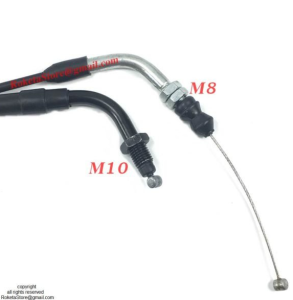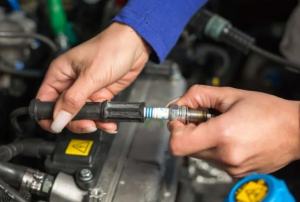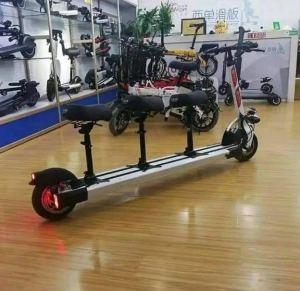Scooter jerking during acceleration often stems from clogged fuel injectors or a dirty air filter.
Common Causes of Acceleration Jerking
Fuel System Issues
Fuel system problems are a primary culprit when it comes to scooters jerking during acceleration. These issues can range from clogged fuel injectors to a dirty fuel filter or issues with the fuel pump. A clogged fuel injector reduces the amount of fuel delivered to the engine, causing misfires and jerking. Similarly, a dirty fuel filter can impede fuel flow.
- Clogged Fuel Injector: Causes inefficient fuel delivery.
- Dirty Fuel Filter: Reduces fuel flow to the engine.
- Faulty Fuel Pump: Leads to inconsistent fuel supply.
For more information on fuel system components and their functions, visit Fuel System.
Ignition System Malfunctions
The ignition system’s primary role is to ignite the fuel-air mixture within the engine’s combustion chamber. Malfunctions here, such as faulty spark plugs or damaged ignition coils, can lead to incomplete combustion, causing the scooter to jerk during acceleration.
- Faulty Spark Plugs: Lead to poor engine performance.
- Damaged Ignition Coils: Result in inefficient fuel combustion.
Problems with the Air Intake System
The air intake system is responsible for delivering air to the engine’s combustion chamber. Issues like a blocked air filter or leaks in the air intake manifold can severely affect the air-fuel ratio, leading to jerking motions when accelerating.
- Blocked Air Filter: Restricts airflow to the engine.
- Leaks in Air Intake Manifold: Disrupt the optimal air-fuel mixture.
For detailed insights on air intake systems, check Air Intake System.
Drive Belt and Transmission Faults
The drive belt and transmission play a crucial role in transferring power from the engine to the wheels. A worn-out drive belt or transmission issues can cause sudden jerking motions. Transmission problems might include damaged gears or issues with the CVT (Continuously Variable Transmission) system.
- Worn-out Drive Belt: Leads to inefficient power transfer.
- Transmission Issues: Affect the scooter’s ability to accelerate smoothly.
Comparison Table
| Issue Category | Common Problems | Impact on Scooter |
|---|---|---|
| Fuel System Issues | Clogged Injector, Dirty Filter | Reduces fuel flow, leading to misfires and jerking. |
| Ignition System Malfunctions | Faulty Spark Plugs, Damaged Coils | Causes incomplete combustion. |
| Air Intake System Problems | Blocked Air Filter, Intake Leaks | Affects air-fuel ratio, causing acceleration issues. |
| Drive Belt and Transmission Faults | Worn-out Belt, Transmission Damage | Leads to inefficient power transfer and jerky motion. |
Maintenance and prevention are key to avoiding these issues. Regularly replacing the fuel filter, spark plugs, and air filter, along with inspecting the drive belt and transmission, can greatly reduce the likelihood of your scooter jerking during acceleration.
Troubleshooting Acceleration Issues
Diagnosing Fuel System Problems
To diagnose fuel system issues, start with the basics: check the fuel level and quality. Contaminated fuel can lead to poor engine performance. Next, inspect the fuel filter for blockages and the fuel injectors for clogging. A fuel pressure test can determine if the fuel pump is operating within the manufacturer’s recommended specifications.
- Check Fuel Quality: Ensure the fuel is not contaminated.
- Inspect Fuel Filter: Look for blockages that impede fuel flow.
- Fuel Injector Examination: Check for signs of clogging.
- Fuel Pressure Test: Verify the fuel pump’s pressure is within specifications.
For a comprehensive understanding of fuel systems, explore Fuel System.
Checking the Ignition System
To ensure the ignition system is functioning correctly, start by inspecting the spark plugs. Worn or fouled spark plugs can significantly affect engine performance. Use a spark plug tester to check for a strong spark. Examine the ignition coils and wires for wear or damage. A multimeter can help measure the resistance and ensure it matches the specifications.
- Spark Plug Inspection: Check for wear or fouling.
- Test Spark Strength: Use a spark plug tester.
- Examine Ignition Coils and Wires: Look for wear or damage.
- Resistance Measurement: Use a multimeter to check resistance.
Inspecting the Air Intake and Filter
A visual inspection of the air filter can reveal if it’s clogged or dirty, which restricts airflow to the engine, impacting performance. A clean air filter ensures optimal air flow. Check the air intake manifold for any signs of leaks or cracks. Ensuring airtight seals in the air intake system is crucial for maintaining the correct air-fuel ratio.
- Air Filter Check: Look for clogs or dirt.
- Air Intake Manifold Inspection: Check for leaks or cracks.
- Ensure Airtight Seals: Verify the integrity of the air intake system.
A detailed article on air filters can be found at Air Filter.
Evaluating Drive Belt and Transmission Health
Inspect the drive belt for signs of wear, cracking, or fraying. A well-maintained drive belt is essential for smooth acceleration. In terms of the transmission, listen for unusual noises or difficulty in shifting. For scooters with a CVT, check the condition of the belts and pulleys. Regular transmission fluid checks ensure that the system operates smoothly.
- Drive Belt Inspection: Check for wear or damage.
- Transmission Check: Listen for unusual noises or shifting issues.
- CVT System Inspection: Examine the belts and pulleys.
- Transmission Fluid Level: Ensure it’s within recommended levels.
Comparison Table
| Troubleshooting Area | Key Actions | Tools/Methods Used | Expected Outcome |
|---|---|---|---|
| Fuel System Problems | Check fuel quality, inspect filter/injectors, fuel pressure test | Fuel pressure gauge | Identifies blockages or pump issues |
| Ignition System | Inspect spark plugs, test spark strength, examine coils/wires | Spark plug tester, multimeter | Ensures optimal spark for combustion |
| Air Intake and Filter | Check air filter, inspect intake manifold for leaks | Visual inspection | Guarantees optimal air flow to the engine |
| Drive Belt and Transmission | Inspect drive belt, check transmission, examine CVT belts/pulleys | Visual and auditory inspection, transmission fluid check | Ensures smooth power transfer and gear shifts |
Maintaining each of these components not only helps in troubleshooting acceleration issues but also in enhancing the overall performance and lifespan of your scooter. Regular checks and maintenance can preempt many of these issues, ensuring a smoother ride.
DIY Fixes and Maintenance Tips
Cleaning the Carburetor and Fuel Injectors
A clean carburetor and fuel injectors are vital for smooth engine operation and efficient fuel consumption. Over time, these components can accumulate deposits that affect performance.
Carburetor Cleaning: Using a carburetor cleaner, which costs around $10 to $20, can remove deposits and improve fuel efficiency. The process involves removing the carburetor, disassembling it, and using the cleaner on all parts. This can improve fuel efficiency by up to 10%, depending on the level of buildup.
Fuel Injector Cleaning: A can of fuel injector cleaner added to your fuel tank, costing approximately $15, can help clear minor clogs and deposits. For more severe cases, a professional fuel injection cleaning service, which might cost between $50 and $100, can restore injector performance, potentially improving fuel efficiency by 5% to 15%.
Replacing Spark Plugs and Ignition Components
Spark plugs are crucial for the ignition process, and worn-out spark plugs can lead to misfires and poor fuel economy.
Spark Plug Replacement: The cost of new spark plugs ranges from $2 to $15 each, depending on the quality and material. Replacing spark plugs is relatively simple and requires only basic tools. Fresh spark plugs can improve ignition efficiency by up to 20%, ensuring a smoother start and better fuel economy.
Ignition Component Maintenance: Checking and replacing ignition cables or coils, if necessary, can prevent power losses and misfires. The cost for new ignition coils ranges from $20 to $100+, but maintaining them can increase ignition system efficiency by 10% to 15%.
Servicing the Air Filter
A clean air filter is essential for maintaining optimal air flow to the engine, which is critical for the air-fuel mixture.
Air Filter Service: Replacing a clogged air filter, which typically costs between $10 and $50, is one of the most cost-effective ways to improve fuel efficiency and acceleration. A new air filter can increase engine efficiency by up to 10%, ensuring that the engine receives clean air for combustion.
Adjusting or Replacing the Drive Belt
The drive belt is a critical component in the power transmission system of a scooter.
Drive Belt Adjustment: Proper tensioning of the drive belt can prevent slippage and power loss, especially during acceleration. There’s no cost if you do it yourself, aside from potentially needing a tension gauge, which can cost around $20.
Drive Belt Replacement: A new drive belt costs between $20 and $100, depending on the scooter model and belt quality. Replacing a worn-out drive belt can restore power transmission efficiency to near 100%, directly impacting acceleration and overall performance.
By performing these maintenance tasks, scooter owners can significantly improve their vehicle’s performance, fuel efficiency, and lifespan. Each of these DIY fixes contributes to a smoother ride, less fuel consumption, and lower long-term maintenance costs, making them valuable skills for any scooter owner.
When to Seek Professional Help
Identifying Complex Electrical Issues
Electrical problems in scooters can range from simple blown fuses to complex issues like ECU (Engine Control Unit) failures. Symptoms of complex electrical issues include intermittent power loss, failure to start, and erratic instrument panel behavior. These problems often require specialized diagnostic tools for accurate troubleshooting, such as multimeters and OBD (On-Board Diagnostics) scanners, which can cost from $20 to over $100 for advanced models. Professional mechanics have the expertise and equipment to diagnose and fix these issues efficiently. Attempting to fix complex electrical issues without the proper knowledge can lead to further damage, potentially increasing repair costs significantly.
Dealing with Severe Engine Problems
Severe engine problems, such as overheating, loss of power, or unusual noises, can indicate significant issues ranging from blown head gaskets to cracked engine blocks. Repairing or rebuilding an engine requires a high level of expertise and can cost anywhere from a few hundred to several thousand dollars, depending on the severity of the damage and the type of scooter. Engine repairs often involve complex disassembly, precise measurement, and machining of components, tasks that are beyond the scope of most DIY enthusiasts. Professional mechanics can ensure that engine repairs are performed correctly, using the right tools and replacement parts, to restore your scooter’s performance and reliability.
Handling Advanced Transmission Repairs
Transmission problems, such as slipping gears or difficulty in shifting, can significantly affect your scooter’s performance. CVT (Continuously Variable Transmission) systems, in particular, involve several components like belts, pulleys, and springs that require precise adjustment. Professional repair of transmission issues can cost between $200 and $600, depending on the complexity of the repair and the parts required. Transmission repairs often require specialized knowledge and tools that are not typically available to the average scooter owner. A professional mechanic can diagnose and repair transmission problems effectively, ensuring that your scooter operates smoothly and reliably.
While many maintenance and repair tasks can be performed by scooter owners, complex electrical issues, severe engine problems, and advanced transmission repairs often necessitate professional assistance. Seeking help from a professional mechanic ensures that these complicated issues are resolved correctly, using the appropriate tools and parts, which can save time, money, and prevent further damage to your scooter.



